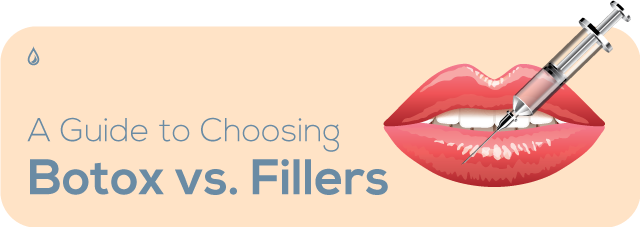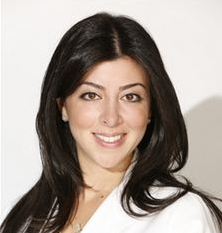
Many of us dream of turning back time, erasing those fine lines and wrinkles that show up on our faces as we age. While we can’t help you literally turn back the clock, the latest advancements in dermatology can dramatically help you maintain (or get back!) healthy, younger-looking skin.
Two of the most effective defenses in the fight against aging skin are Botox and dermal fillers. According to the American Society of Plastic Surgeons, over 9 million people had these procedures in 2017 alone for their anti-aging properties.
But which is right for you? Botox? Fillers? Both?
We spoke with Dr. Charlotte Noorollah of The Dermatology Specialists to get some insight into the similarities and differences between Botox and fillers. Read on for everything you’d want to know before making this decision.
While both Botox and fillers prevent and reduce the signs of wrinkles, they differ in purpose and function.
“Botox, the brand name for Botulinum neurotoxin A, is an injectable medicine used to relax facial muscles that contribute to fine lines and wrinkles. It works by stopping the nerve signals in the muscles at the injection site,” says Dr. Noorollah.
When these nerve signals are disrupted, they temporarily paralyze or freeze the muscles to decrease movement and thus soften, reduce or remove wrinkles. The treatment usually lasts up to three to four months for patients.
Dermal fillers, on the other hand, are typically made of synthetic substances that are injected underneath the skin to restore volume and fullness.
Dr. Noorollah explains: “Commonly used substances include hyaluronic acid with brands like Juvederm and Restylane helping to reduce superficial to moderate wrinkles. A calcium hydroxylapatite form like Radiesse can be used for deeper wrinkles or to restore structure like when redefining the jawline.”
Conveniently, fillers last anywhere from six months to two years and don’t require as much upkeep as Botox procedures.
Botox is most effective on wrinkles that are caused by muscle movement, so it improves “expression lines”, the fine lines or wrinkles caused by smiling, frowning, squinting and other facial expressions.
Many people decide to get Botox when these lines become visible around the upper face — e.g., crows feet around the eyes, horizontal lines on the forehead and the lines between the brow.
On the plus side, Botox can also be preventative.
“When Botox is administered at an earlier age, fine lines can be reduced by paralyzing the injected muscles,” explains Dr. Noorollah.
One important caveat: Botox is not effective on fine lines and wrinkles caused by sagging or loss of plumpness, otherwise known as static wrinkles. That’s when patients should consider fillers instead.
Fillers target different areas, restoring volume in the midface, nasolabial folds, jowls, or lips. You might recognize Kylie Jenner’s infamous pout as a good example of someone who has undergone filler procedures to enhance their lip shape.
Although there are different types of fillers, there is no one particular type that is necessarily better than the other. The provider who administers the filler should have a thorough understanding of anatomy because there is a very small risk of vascular necrosis (death of tissue) if fillers are injected incorrectly.
While both Botox and fillers have specific benefits (hello, smooth skin!), they each come with their own potential side effects.
Following Botox injections, patients may experience minor redness at the injection site, bruising, localized sweating, flu-like symptoms and a minor headache. More rare complications may include ptosis or drooping eyelids, which often go away within four to six weeks or is reversible with a procedure. It’s also important for patients to avoid exercising or other vigorous activities up to four hours after the injection.
“Similar to Botox, fillers cause swelling, bruising, redness, but sometimes visible or non-visible lumps also occur under the skin. Lips tends to swell more because there is little space for tissue to expand when the product is injected. These common side effects are usually moderate and disappear within two weeks,” says Dr. Noorollah.
Fillers have more potential risks than Botox injections. Severe side effects like trouble breathing, swallowing and muscle weakness are unlikely, but patients are advised to avoid rubbing or massaging the treated areas after the procedure because it increases the risks of the injectables spreading to other areas of the face and increases the chances of severe symptoms.
One upside of choosing between Botox and fillers is that neither of them are permanent, which often makes nervous patients feel much more comfortable about making enhancements to their skin.
Either way, Dr. Noorollah advises patients to talk with a board-certified dermatologist to talk through individual concerns and the desired outcome. Not only will they help you decide whether Botox or fillers work better for your specific skin care concern, they’ll also be able to speak to any potential complications or considerations based on your skin type.
Botox and dermal fillers can be incredibly empowering, whether you’re a grandmother looking to embrace her wrinkles or a 30-something professional who wants to remove fine lines for a LinkedIn headshot.
If we can’t use a time machine to turn back time, these procedures are certainly a convincing alternative.
 Charlotte Noorollah, DO is a board-certified dermatologist and board-certified family practitioner at The Dermatology Specialists. She is a member of the American Academy of Dermatology, the American Osteopathic College of Dermatology, the American Medical Association, the New York State Osteopathic Medical Society, and the Women’s Dermatologic Society.
Charlotte Noorollah, DO is a board-certified dermatologist and board-certified family practitioner at The Dermatology Specialists. She is a member of the American Academy of Dermatology, the American Osteopathic College of Dermatology, the American Medical Association, the New York State Osteopathic Medical Society, and the Women’s Dermatologic Society.